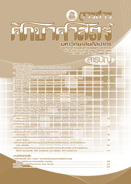การพัฒนาระบบการบริหารงานการประกันคุณภาพการศึกษาของคณะศึกษาศาสตร์ มหาวิทยาลัยศิลปากร
Main Article Content
Abstract
วิธีดำเนินการวิจัย ใช้ระเบียบวิธีวิจัยเชิงคุณภาพ โดยมุ่งศึกษาองค์กรที่มีวิธีการปฏิบัติที่เป็นเลิศในด้านการประกันคุณภาพการศึกษา ได้แก่ คณะศึกษาศาสตร์ มหาวิทยาลัยมหาสารคาม และคณะศึกษาศาสตร์มหาวิทยาลัยนเรศวร เก็บรวบรวมข้อมูลโดยวิธีการสังเกตแบบไม่มีส่วนร่วม การสัมภาษณ์ การสนทนากลุ่ม และการวิเคราะห์เอกสาร วิเคราะห์ข้อมูลด้วยการจำแนกประเภทของข้อมูล (Typological Data) การเปรียบเทียบข้อมูลการสร้างข้อสรุปเชิงอุปนัย (Analytic Induction) การวิเคราะห์เนื้อหา (Content Analysis) และการวิเคราะห์ช่วงห่าง (Gap Analysis)
ผลการวิจัย พบว่า
1. การเทียบเคียงสมรรถนะด้านปรัชญา ปณิธาน วิสัยทัศน์ พันธกิจ พบว่า คณะศึกษาศาสตร์ทั้งสามมหาวิทยาลัย มีปรัชญา ปณิธาน วิสัยทัศน์ และพันธกิจ ที่สอดคล้องกันในการผลิตบัณฑิตครูที่มีความเป็นเลิศในวิชาชีพ และจัดการศึกษาทุกระดับอย่างมีคุณภาพได้มาตรฐานเป็นที่ยอมรับในระดับสากล การเทียบเคียงสมรรถนะด้านผลการประกันคุณภาพการศึกษาพิจารณาจากคะแนนการประเมินตามเกณฑ์ สกอ. และ สมศ. พบว่ามีคะแนนรายตัวบ่งชี้ซึ่งเป็นคะแนนการประเมินเท่ากันเป็นส่วนใหญ่ โดยตัวบ่งชี้ที่มีคะแนนแตกต่างกันอย่างชัดเจน ร้อยละ 40 ขึ้นไป ได้แก่ ตัวบ่งชี้อาจารย์ประจำที่ดำรงตำแหน่งทางวิชาการ ตัวบ่งชี้ระบบและกลไกการพัฒนาและบริหารหลักสูตร ตัวบ่งชี้ระบบและกลไกการจัดการเรียนการสอน และตัวบ่งชี้ผลงานของผู้สำเร็จการศึกษาระดับปริญญาเอกที่ได้รับการตีพิมพ์หรือเผยแพร่ การเทียบเคียงสมรรถนะกระบวนการประกันคุณภาพด้านปัจจัยนำเข้า พบว่าตัวบ่งชี้ที่มีความแตกต่างกัน ได้แก่ ตัวบ่งชี้อาจารย์ประจำที่มีคุณวุฒิปริญญาเอก ตัวบ่งชี้อาจารย์ประจำที่ดำรงตำแหน่งทางวิชาการ ตัวบ่งชี้ห้องสมุด อุปกรณ์การศึกษา และสภาพแวดล้อมการเรียนรู้ การจัดการและให้บริการคอมพิวเตอร์ และตัวบ่งชี้เงินสนับสนุนงานวิจัย ด้านกระบวนการ มีความแตกต่างกันในตัวบ่งชี้การพัฒนาแผน ตัวบ่งชี้ระบบและกลไกการพัฒนาและบริหารหลักสูตร ตัวบ่งชี้ระบบและกลไกการจัดการเรียนการสอน ตัวบ่งชี้ระบบและกลไกการพัฒนาสัมฤทธิ์ผลการเรียนตามคุณลักษณะของบัณฑิต ตัวบ่งชี้ระบบและกลไกการพัฒนางานวิจัยหรืองานสร้างสรรค์ ตัวบ่งชี้ระบบและกลไกการจัดการความรู้จากงานวิจัยหรืองานสร้างสรรค์ ตัวบ่งชี้ระบบและกลไกการบริการทางวิชาการแก่สังคม ตัวบ่งชี้กระบวนการบริการทางวิชาการให้เกิดประโยชน์ต่อสังคม ตัวบ่งชี้ระบบและกลไกการทำนุบำรุงศิลปะและวัฒนธรรม ตัวบ่งชี้ภาวะผู้นำของสภาสถาบันและผู้บริหารทุกระดับของ ตัวบ่งชี้การพัฒนาสถาบันสู่สถาบันเรียนรู้ ตัวบ่งชี้ระบบสารสนเทศเพื่อการบริหารและการตัดสินใจ ตัวบ่งชี้ระบบบริหารความเสี่ยง ตัวบ่งชี้ระบบและกลไกการเงินและงบประมาณ ตัวบ่งชี้ระบบและกลไกการประกันคุณภาพการศึกษาภายใน และตัวบ่งชี้ที่สะท้อนอัตลักษณ์ สำหรับตัวบ่งชี้ระบบและกลไกการให้คำปรึกษาและบริการด้านข้อมูลข่าวสาร ตัวบ่งชี้ระบบและกลไกการส่งเสริมกิจกรรมนักศึกษา มีความสอดคล้องกัน และด้านผลลัพธ์ ตัวบ่งชี้ระดับความสำเร็จของนักศึกษามีความสอดคล้องกัน
2. วิธีการปฏิบัติที่เป็นเลิศในการดำเนินการประกันคุณภาพการศึกษา ประกอบด้วย กระบวนการมีส่วนร่วมของบุคลากร การเสริมสร้างภาวะผู้นำเข้มแข็งที่มีการเตรียมความพร้อมและสร้างความตระหนักให้บุคลากรโดยการจัดการความรู้ (KM) เพื่อการเข้าสู่ความเป็นมาตรฐานสากล สร้างกระบวนการดำเนินงานที่มีประสิทธิภาพได้มาตรฐานโดยการวางแผนที่ดี กำหนดและกระจายความรับผิดชอบ บุคลากรร่วมกันดำเนินการตามแผนอย่างรัดกุมเป็นระบบ มีการตรวจสอบที่น่าเชื่อถือและปรับปรุงการปฏิบัติงานเพื่อจัดทำข้อมูลสารสนเทศที่เป็นประโยชน์ต่อการพัฒนาคุณภาพการศึกษา
3. แนวทางการพัฒนาระบบการบริหารการประกันคุณภาพการศึกษา คณะศึกษาศาสตร์ มหาวิทยาลัยศิลปากร ประกอบด้วย 1) ขั้นการวางแผนและเตรียมความพร้อมด้วยการมีส่วนร่วมสร้างความเข้าใจและความตระหนักถึงความสำคัญจากทุกภาคส่วน วิเคราะห์แผนกลยุทธ์และแปลงแผนไปสู่การปฏิบัติการโดยจัดทำแผนที่ยุทธศาสตร์ (Strategic map) ดำเนินการเขียนโครงการที่สอดคล้องกับการประกันคุณภาพการศึกษา 2) ขั้นการดำเนินงาน ได้แก่ การปฏิบัติตามแผนแบบมีส่วนร่วมของบุคลากรในสถาบัน พัฒนาระบบและกลไกการจัดการศึกษาที่มีประสิทธิภาพครอบคลุมงานทุกด้านให้มีการเชื่อมโยง (Link) 3) ขั้นการตรวจสอบ ขั้นปรับปรุง พบว่า กระบวนการตรวจสอบควรมาจากภาควิชาและคณะ โดยพิจารณาความสอดคล้องของยุทธศาสตร์และตัวชี้วัด (KPI) มีการนำเสนอผลต่อผู้เกี่ยวข้องและจัดทำเป็นข้อมูลสารสนเทศเพื่อสะท้อนการประกันคุณภาพและ4) ประเด็นสนับสนุนอื่นๆ ได้แก่ ภาวะผู้นำที่เข้มแข็งของสภาสถาบันและผู้บริหารให้ความสำคัญกับการประกันคุณภาพการศึกษาและมีวิสัยทัศน์ในการเตรียมความพร้อมเข้าสู่ประชาคมอาเซียน โดยควรกำหนดระบบกลไกการบริหารและการประกันคุณภาพการศึกษาในรูปแบบทิศทางเดียวกัน รวมไปถึงการสร้างเครือข่ายในการแลกเปลี่ยนเรียนรู้เพิ่มสมรรถนะการปฏิบัติงานแก่บุคลากรที่จะช่วยสนับสนุนการพัฒนางานประกันคุณภาพการศึกษาของคณะศึกษาศาสตร์ มหาวิทยาลัยศิลปากร
The Developmont of the Education Quality Assurance Administration System of the Faculty of Education, Silpakorn University
The research topic “The Development of the Educational Quality Assurance Administration System of the Faculty of Education, Silpakorn University” had the following objectives: 1) to benchmark the administrative procedure and the outcome of quality assurance between the Faculty of Education, Silpakorn University and the Faculty of Education with the best practice, 2) to study the best practice in quality assurance of the Faculty of Education and 3) to study the method of development of the educational quality assurance administration system of the Faculty of Education, Silpakorn University.
The qualitative research methodology was carried out by studying the organizations with best practice in educational quality assurance. They were the Faculty of Education of Mahasarakham University and Naresuan University. The data was collected via non-participant observation, interviewing, group discussion, and documentary analysis. The data was then analyzed by typological data analysis, data comparison by analytic induction, content analysis, and gap analysis.
The research outcomes were as follows :
1. Benchmark in philosophy, vision, and commitment showed that the Faculty of Education of all three Universities had compatible philosophy, visions, and commitment in producing teachers with professional excellence and management of all levels of education with quality and the globally accepted standard. The benchmarking of educational quality assurance by considering the OHEC and ONESQA evaluation points criterion showed that the evaluation points in majority of the indicators were equal. The indicators with clear difference more than 40 percent were the indicator of full-time instructors holding an academic position, the indicator of system and mechanism for curriculum development and administration, the indicator of system and mechanism for teaching and learning management and the indicator of works of the doctor of philosophy degree graduated students which were published Benchmarking of the inputs quality assurance process showed the difference in the indicator of Full-time instructors holding a doctora degree, indicator of full-time instructors holding doctoral an academic position, library, educational equipment, indicator of learning environment and computer management and services, and the indicator of researching funds. The process benchmark showed the difference in plan development process indicator, system and mechanism for curriculum development and administration indicator, system and mechanism for teaching and learning management indicator, system and mechanism to develop the educational achievements according to graduate characteristics indicator, system and mechanism to develop research or creative work indicator, system and mechanism to manage the knowledge gained from research or creative work indicator, system and mechanism for academic services to the society indicator, academic service process for the benefit of the society indicator, system and mechanism for the preservation of arts and culture indicator, leadership of the institution council and administrators at all levels of the institution indicator, Institutional development towards learning institution indicator, information system for administration and decision-making indicator, risk management system indicator, system and mechanism for finance and budgeting indicator, system and mechanism for internal quality assurance indicator, and Identity reflection indicator. As for the System and mechanism to provide information advice and services indicator and System and mechanism to promote student activities indicator, they were in concordance. As a result, Students’ level of success indicator was in concordance.
2. The best practice in quality assurance operation consisted of the process of personnel’s participation, the strengthening of strong leadership, preparation and making awareness to the personnel using knowledge management (KM) in order to archive the global standards, creating the process with effectiveness and conforming to the standards via good planning, defining and distributing responsibilities, creating a well-defined guidelines and schedules, systematic and concise participation of personnel in the implementation of the plan, credible inspection, and improvement of the operations to provide the information that are beneficial to the educational quality control.
3. Course of the quality assurance administration system development of the Faculty of Education, Silpakorn University consisted of 1) The phase of planning and preparation with participation in making understanding and importance awareness of all parties, analyzing the strategies and convert them into actions by making strategic map, and writing projects that corresponds to the quality assurance. 2) The phase of actions, i.e., participation of the staff of the institution in the implementation of the plans, development of the educational management system and mechanism that effectively link all aspects. 3) For the phase of verification and improvement, we found that, the checking process should come from the department and the Faculty by considering the correspondence of strategies and the key performance indicator (KPI). The results have been presented to the person involved and the information is prepared to reflect the quality assurance. Finally 4) support issues, i.e., the strong leadership of the institution council and the executives emphasize the quality assurance a have visions in preparation for entering the Asian Economic Community (AEC). The mechanism of the administration and the quality assurance should be set in the form of directions, including creating the operational efficiency improvement exchange network for the staff to support the quality assurance development of the Faculty of Education, Silpakorn University.


